To tell if your coffee’s fresh, check the roast date; aim to enjoy it within 7-10 days post-roasting. Look for a foamy bloom when brewing—this means it’s fresh. Smell is key too; a strong, pleasant aroma indicates quality, while a musty scent means staleness. Examine the beans; they should feel smooth and shiny, not dull or oily. Proper storage is essential as well. Keep going to discover more tips for keeping your coffee fresh!
Key Takeaways
- Check the roast date; fresh coffee is best enjoyed within 7-10 days post-roasting for optimal flavor.
- Look for a rich bloom during brewing; a foamy appearance indicates freshness, while a flat look suggests staleness.
- Smell the coffee; a strong, pleasant aroma signifies freshness, whereas musty or dull odors indicate aging.
- Examine the beans for a glossy shine; excessive oiliness may mean the coffee is stale.
- Store coffee in airtight containers away from light and moisture to maintain freshness longer.
Understanding Coffee Freshness
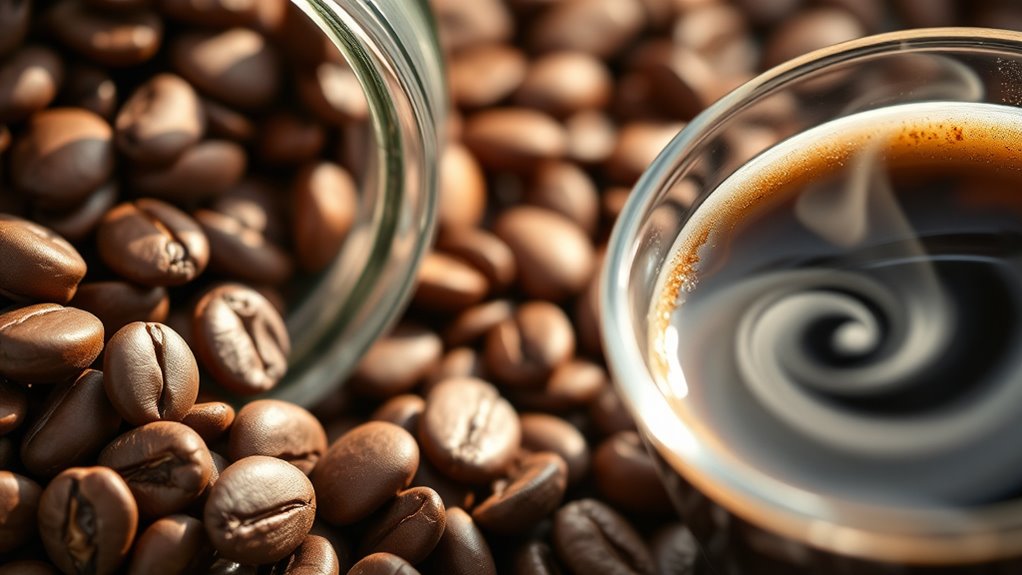
When you plunge into the world of coffee, understanding freshness is essential to enjoying the best flavors.
Fresh coffee typically reaches its peak freshness 4-14 days after roasting, where the aroma greatly enhances taste. As roasted beans lose mass and become more porous during roasting, aromatic compounds diminish over time, impacting overall freshness.
Fresh coffee is at its best 4-14 days post-roasting, where enhanced aroma plays a crucial role in flavor.
To maintain that delightful flavor, proper storage and packaging are vital; exposure to oxygen can quickly degrade your coffee.
Keep in mind that perceptions of coffee freshness can vary based on origin and processing methods, which can influence your flavor experience.
The Importance of Roast Date
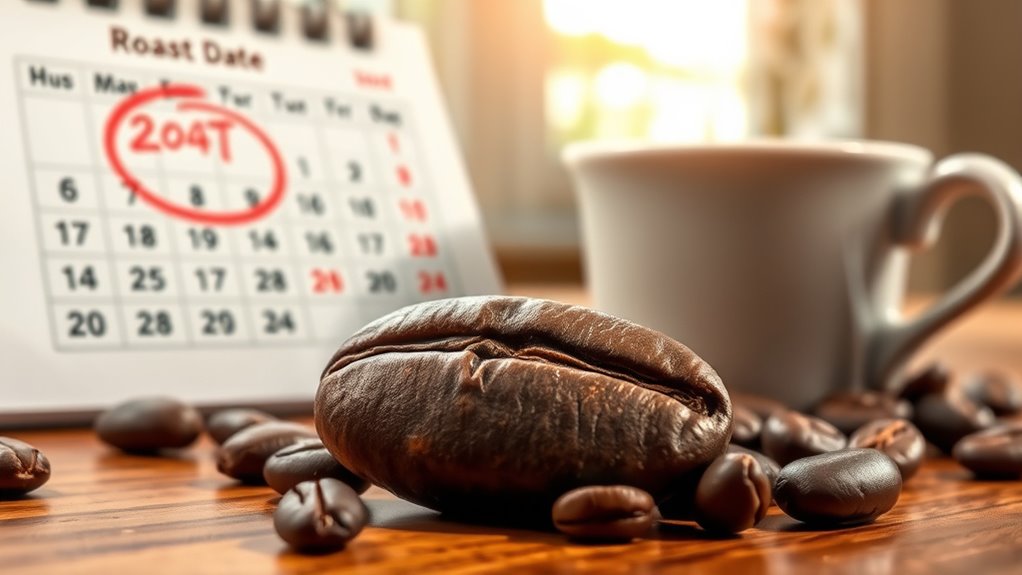
Although many factors contribute to coffee’s flavor, the roast date stands out as one of the most critical indicators of freshness.
Ideally, you should enjoy your coffee within 7-10 days of being roasted. This time frame allows the flavors to peak, ensuring you get the best taste possible.
While some brands proudly display their roast dates, others may not, so it’s essential to ask about freshness when buying. Opt for coffee roasted within the last week to guarantee a delightful flavor experience.
Keep in mind that freshness diminishes considerably after two to three weeks. Brands like Atlas Coffee Club prioritize roasting coffee to order, which guarantees you’ll receive the freshest coffee available.
Identifying the Coffee Bloom

When you brew fresh coffee, watch for the coffee bloom—the foamy bubbles that rise to the surface.
This bloom is a clear sign of freshness, as it indicates the release of carbon dioxide from the beans.
Using methods like pour-over or Chemex not only helps you see the bloom but also enhances the flavor extraction process.
Visual Indicators of Freshness
The coffee bloom is an essential visual cue for evaluating freshness in your brew. When you notice a pale, foamy bloom, it’s a clear sign that your coffee is fresh. This phenomenon occurs when hot water interacts with recently roasted coffee beans, releasing carbon dioxide.
Here are three key indicators to look for:
- Foam Presence: A rich, bubbly bloom indicates freshness, while a flat appearance suggests staleness.
- Timing: Fresh coffee typically blooms within 14 days post-roasting, so check your coffee’s roast date.
- Brewing Method: Techniques like pour-over benefit from monitoring the bloom for enhanced flavor extraction.
Brewing Method Importance
Understanding brewing methods is essential for maximizing the coffee bloom‘s potential.
When you pour hot water over freshly ground coffee, you’ll notice a pale, foamy layer forming—this is the bloom. This reaction occurs as carbon dioxide (CO2) trapped in the beans during roasting escapes, indicating that you’re working with fresh coffee.
The blooming process enhances flavor extraction, particularly in pour-over techniques like Chemex. Pay attention to how your coffee blooms; if it bubbles up beautifully, you’re likely enjoying quality beans.
However, if you see little to no foam, your coffee might be stale, leading to a lackluster flavor profile. Additionally, fresh coffee contains antioxidants that combat oxidative stress, which can further enhance your overall coffee experience.
Evaluating Aroma and Flavor

Aromatic allure plays an essential role in identifying the freshness of your coffee. To evaluate aroma and flavor effectively, pay attention to these key indicators:
Aroma is vital for assessing coffee freshness; strong fragrances indicate quality, while musty smells signal staleness.
- Aroma: Fresh coffee emits a strong, intense fragrance that enhances your experience. If it smells musty or rancid, it’s likely stale.
- Flavor: Fresh coffee showcases distinct flavor notes. If your brew tastes lifeless or bland, the coffee may have lost its freshness.
- Development: Ideal flavor may take one to two weeks post-roasting. During this time, both aroma and taste will evolve positively.
Analyzing Bean Appearance

When you look at your coffee beans, pay attention to their surface. A glossy shine can indicate freshness, while excessive oiliness might point to staleness.
Also, check the texture; fresh beans should feel smooth and intact, not dry or crackly.
Glossy Surface Assessment
To determine the freshness of your coffee beans, one of the easiest methods is to assess their glossy surface. Fresh coffee beans typically display a shiny, glossy exterior, a result of natural oils released during roasting.
Here’s what to look for:
- Healthy Glossiness: Both dark and light roast beans should have a vibrant sheen, indicating freshness.
- Avoid Over-Greasiness: If the beans feel overly greasy, they may have been exposed to oxygen too long, leading to staleness.
- Check for Dryness: Beans that are dry or crackly lack the glossy surface of fresh coffee and signal staleness.
Oil Residue Inspection
One key aspect of evaluating your coffee’s freshness is the oil residue it leaves behind. Freshly roasted coffee beans typically leave a slight oil residue on your hands, signaling they’ve retained their natural oils.
When you inspect the inside of the coffee bag, a shiny oil lining indicates freshness and minimal exposure to oxygen. In contrast, stale beans appear dry and crackly, showing a loss of freshness and oiliness.
Keep in mind that dark roast beans might’ve more visible oil due to the roasting process, which doesn’t necessarily mean they’re fresher.
Monitor the oiliness of your beans; they need to exhibit some glossiness without being overly greasy for ideal quality.
Bean Texture Evaluation
Evaluating the texture and appearance of coffee beans offers valuable insights into their freshness. When you inspect your beans, keep these points in mind:
- Shine: Freshly roasted beans usually have a glossy sheen from the oils released during roasting. Stale beans, in contrast, look dry and crackly.
- Color: Quality coffee should maintain a vibrant color. Older beans often lose their luster and may develop an oily residue that signals staleness.
- Oil Presence: A light oiliness enhances flavor, while dry beans suggest aging. If your beans lack that desirable oil, it’s time to reconsider their freshness.
The Role of Carbon Dioxide

How does carbon dioxide impact the freshness of your coffee?
During the roasting process, coffee roasted beans break down sugars and amino acids, releasing carbon dioxide (CO2). For about 14 days after roasting, freshly roasted beans continue to emit CO2, greatly affecting your coffee’s brewing quality.
The first week is especially vital for flavor development; the buildup of CO2 enhances extraction during brewing. Dark roasts, due to their increased porosity, degas faster than light roasts, which means you should brew them sooner for ideal flavor.
The first week post-roasting is crucial; CO2 buildup enhances flavor extraction, especially in dark roasts that degas quickly.
Allowing your coffee to rest before brewing lets it degas, resulting in a more aromatic and flavorful cup. Understanding this role of CO2 can help you enjoy the freshest coffee possible.
Packaging and Storage Considerations

When it comes to keeping your coffee fresh, packaging matters.
Look for bags with degassing valves to let carbon dioxide escape while keeping oxygen out, and always opt for airtight storage solutions. Additionally, understanding the brewing methods can help you choose the right coffee for your preferred taste and freshness level.
Valve Packaging Importance
Although you mightn’t think about it, the packaging of your coffee plays an essential role in maintaining its freshness.
Using valve packaging is vital for preserving your coffee’s quality. Here’s why:
- CO2 Release: Freshly roasted beans emit carbon dioxide (CO2). Valve packaging allows this gas to escape, preventing bag inflation while keeping oxygen out.
- Oxidation Prevention: Without a degassing valve, oxygen exposure increases and can lead to staleness, ruining the flavor and aroma you love.
- Extended Shelf Life: Properly sealed bags with valves protect against moisture and air, ensuring maximum freshness for several weeks after roasting.
Choosing coffee in valve packaging can make a significant difference in your daily brew!
Airtight Storage Solutions
To keep your coffee tasting its best, investing in airtight storage solutions is essential. Airtight storage containers minimize exposure to air, preventing oxidation and staleness, which can ruin your brew.
Consider using vacuum-sealed bags; they can maintain coffee freshness longer than standard packaging, keeping beans flavorful for six to seven weeks after opening.
To further protect your coffee, choose opaque containers that shield against light, which can degrade flavor compounds over time. Store your coffee in a cool, dark place to prevent heat and moisture from accelerating aging.
Grinding Coffee for Freshness
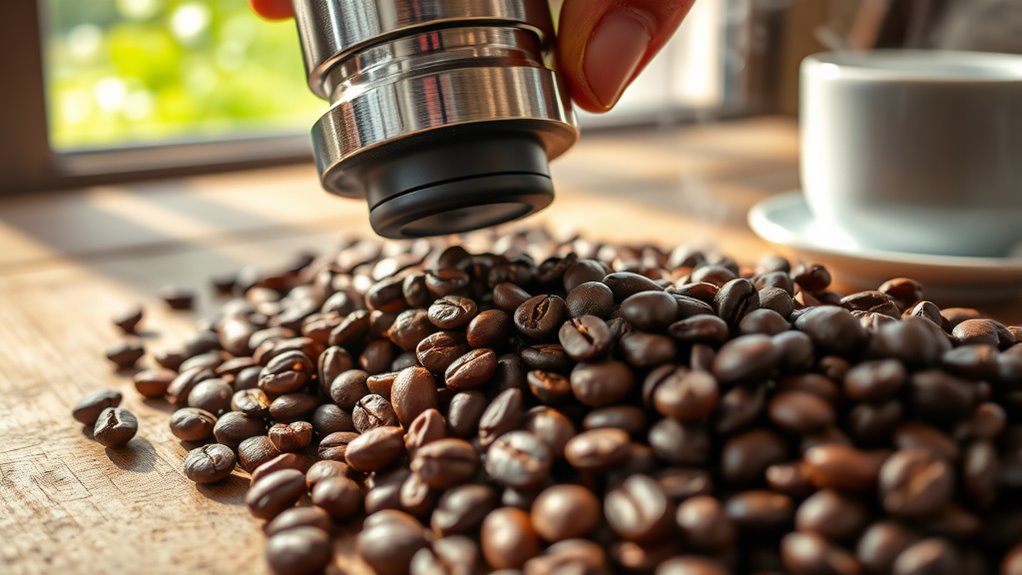
Grinding coffee just before brewing is essential for maximizing freshness and flavor. Whole coffee beans stay fresh longer than ground coffee, which typically lasts only one to two weeks.
To guarantee your coffee is fresh, follow these tips:
- Grind the beans no more than 48 hours before brewing to minimize flavor loss.
- Use quality grinders and grind in small batches if you can’t grind right before brewing.
- Check your coffee for signs of moisture exposure, as pre-ground coffee can lose its aroma and flavor quickly.
Brewing Methods and Timing
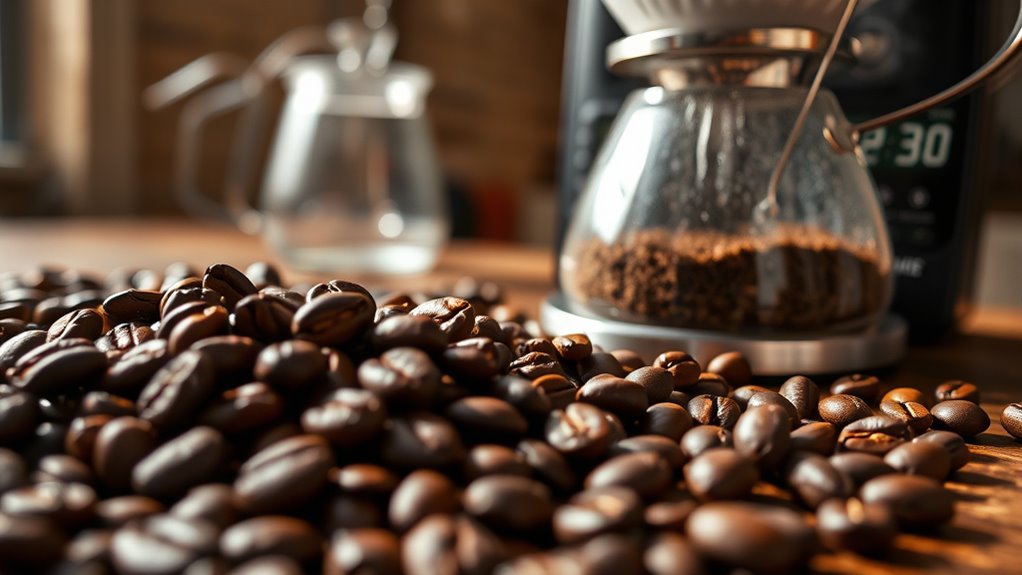
When you brew coffee, the timing after roasting plays a crucial role in achieving the best flavor.
Timing after roasting is essential for unlocking the best flavors in your coffee.
For gentle brewing methods like drip and pour-over, you can use coffee that’s been roasted within the last 4-7 days for ideal flavor extraction.
However, if you’re making espresso, give it at least 7-11 days to allow the flavors to develop properly.
For cold brew, aim for beans that have rested for 10-14 days to get that smooth taste.
Remember, the recommended waiting times can vary based on roast degree, bean density, and processing methods.
Dark roasts should be brewed sooner to avoid rancidity, so keep an eye on the time to off-gas to enjoy the freshest cup possible. Additionally, using coarsely ground coffee is essential for methods like French Press operation to ensure optimal extraction and flavor.
Taste Test for Freshness
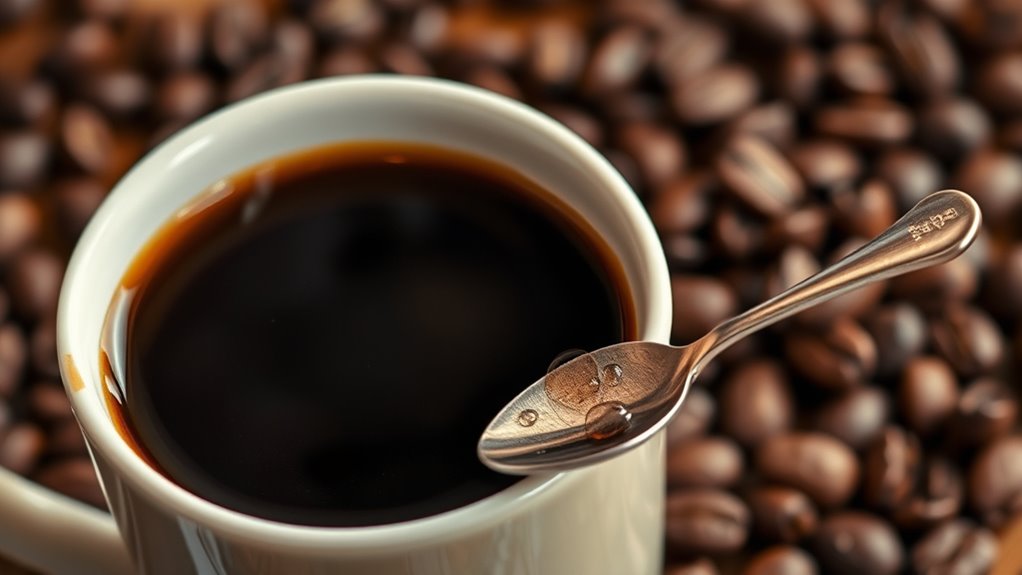
How can you truly tell if your coffee is fresh? A simple taste test can reveal the freshness of your brew. Here’s how to compare:
- Aroma Check: Fresh coffee grounds should have a vibrant, pleasant aroma. If it smells musty or rancid, it’s likely stale.
- Bloom Observation: During brewing, watch for blooming. Fresh coffee grounds will exhibit foamy bubbles, indicating carbon dioxide release, essential for flavor extraction.
- Flavor Comparison: Brew a dark roast from fresh beans and older ones side by side. You’ll notice the fresh coffee offers clearer, more vibrant flavor notes, while the stale cup tastes flat and lifeless.
Trust your taste buds; they’ll guide you to the freshest cup!
Frequently Asked Questions
How Can You Tell if Coffee Is Fresh?
You can tell if coffee is fresh by checking the roast date on the bag; ideally, it should be within the last week.
Look for glossy beans, which indicate retained oils, while dry beans suggest staleness. A strong aroma points to freshness, while a lack of smell hints at age.
When brewing, fresh coffee will bloom, and you can also seal beans in a Ziploc bag overnight; if it inflates, they’re fresh!
What Does Too Fresh Coffee Taste Like?
Too fresh coffee can taste overly bright and tangy, with a sharp acidity that may overwhelm your palate.
You might notice intense aromas that mask subtler flavors, leading to a less balanced cup.
When brewing, you’ll see a pronounced bloom due to excess carbon dioxide, affecting flavor extraction.
The mouthfeel may feel thin, lacking complexity, as the flavors haven’t had enough time to mellow and harmonize.
Waiting a bit can enhance your coffee experience.
What Does Fresh Coffee Look Like?
Fresh coffee looks like it just came back from a spa day—glossy, vibrant, and full of life!
You’ll notice a shiny surface from natural oils, not that sad, dry look of old beans. If it leaves an oily residue on your fingers, you’re in luck!
Also, check for degassing valves on the bag; they’re like little bouncers keeping the staleness out.
How Do I Know if My Coffee Is Good?
To know if your coffee is good, trust your senses. Smell the beans; a strong, inviting aroma means freshness.
When brewing, look for a bloom—if the grounds foam up, you’re in good shape. Check the roast date; aim for beans roasted within the last week.
Visually, fresh beans should have a glossy appearance without excessive oiliness. If they seem dry or cracked, it’s a sign they’ve lost their quality.
Enjoy that perfect cup!
Conclusion
In summary, knowing how to tell if your coffee is fresh can elevate your daily brew from ordinary to extraordinary. By paying attention to roast dates, aroma, and packaging, you’re not just drinking coffee; you’re indulging in a cup of pure joy. Remember, freshness isn’t just a detail—it’s the key to revealing flavor that sings like a symphony in your mouth. So, savor every sip and enjoy the vibrant experience that only fresh coffee can provide!









